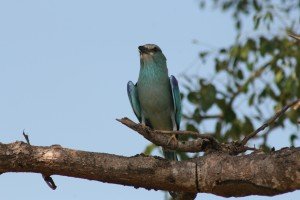Pilanesberg National Park 0
The Secretarybird is one of the great wanderers of the African grasslands, covering 20 to 30km a day as it strides purposefully across the savanna in search of terrestrial prey like insects, amphibians, reptiles, birds and rodents.
There is something imperturbable about them, as if they are on an important quest and will not be distracted. Considered vulnerable, their numbers in decline, I am always happy to see them and it was a hot morning in the Pilanesberg National Park in March when I came across a pair marching across the grasslands beneath the Nkakane hill.
But on this occasion their smooth progress was to be disturbed in humorous fashion. Between myself and the Secretarybirds there were bunches of little thicket-like bushes and resting in the shade of one of them was a Steenbok … I was the only one who could foresee what would happen next.
The raptors made inexorable progress towards the bush and, as they disturbed the Steenbok, both the birds and the little antelope were surprised with all three charming animals leaping away in fright!
Just before turning on to the Nkakane Link from Tshepe Drive, having entered the park through the KwaMaritane Gate, those selfsame low bushes had Pearlbreasted Swallows perched on top of them. They are one of the Hirundines that spend their time lower to the ground.
These bushes also provide vantage points for the Lesser Grey Shrikes, which thrive in the open spaces of the savanna, as well as providing some shelter from the midday sun when it is especially hot.
I guess 34°C qualifies because respite from the heat seemed to be on everyone’s mind. It was so hot that a Blue Wildebeest sheltering under a thorn tree almost on the road was very reluctant to move away from my car, while even a European Bee-Eater was being surprisingly inconspicuous lurking in the foliage of a tree.
The Hippopotami had the right idea with 13 of them in a little dam, along with two Elephant! Arrowmarked Babblers were also making a beeline, descending towards the water.
Little pools of water formed from streams running down from Magare Hill were also full of life, with Common Waxbills flying up from the water’s edge as I drove past.
The main stream coming out of Mankwe Dam obviously had fish in it because African Spoonbill and Grey Heron were in attendance.
There were no other surprises for me, although it was nice to see Wattled Plover and Wood Sandpiper amongst the Warthog at Tilodi Dam.
Sightings
Blue Wildebeest
Common Waxbill
Impala
African Elephant
Plains Zebra
Lesser Grey Shrike
Blackeyed Bulbul
Pearlbreasted Swallow
African Spoonbill
Grey Heron
Secretarybird
Steenbok
Blacksmith Plover
Hippopotamus
Yellowthroated Sparrow
European Bee-Eater
Arrowmarked Babbler
Egyptian Goose
Warthog
Wattled Plover
Wood Sandpiper
Pied Crow
Greater Striped Swallow
Grey Lourie



